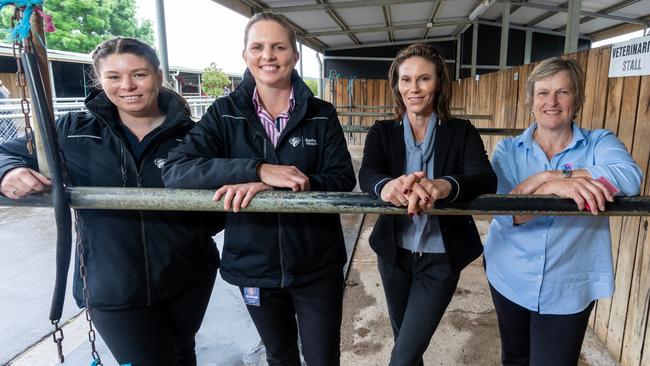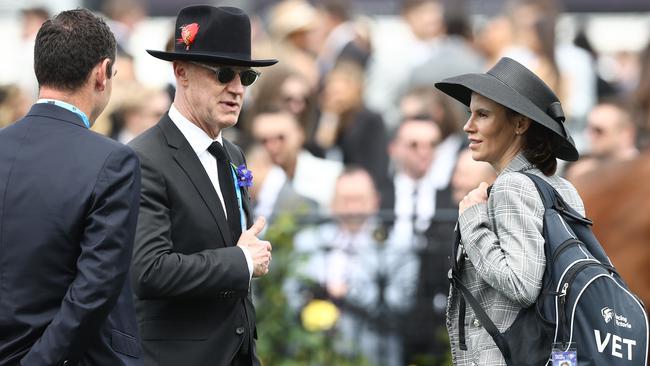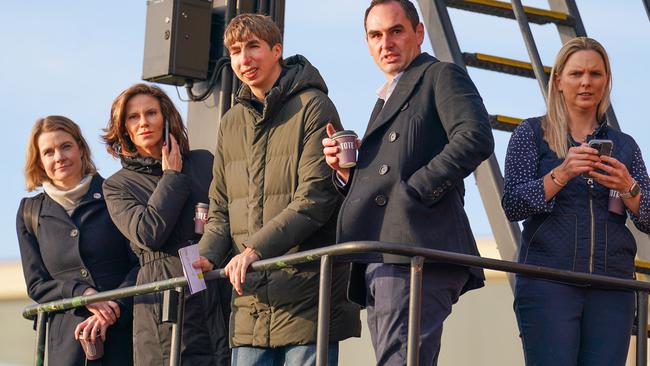Racing Victoria veterinary services boss Dr. Grace Forbes and team prepare for Melbourne Cup Week at Flemington and beyond
Insight: How Racing Victoria’s veterinary services team gets through Melbourne Cup Week at Flemington and beyond.

Horse Racing
Don't miss out on the headlines from Horse Racing. Followed categories will be added to My News.
FLEMINGTON is a centrepiece of Cup Week, but not for the Racing Victoria veterinary services.
The 90-strong team must also account for horses in races scheduled at Ballarat, Bairnsdale, Echuca, Mildura, Bendigo, Pakenham (night), Geelong and Balnarring.
Rinse and repeat next week, with hundreds more horses for the village of vets and ancillary staff to tend to before, during and after another set of city and country race cards.
Last Saturday 122 horses contested nine races at Flemington on Derby day.
About every second horse was subjected to pre and post-race blood and urine samples for analysis, examinations and endoscopy.
The secondary race card at Traralgon got “exactly” the same treatment, on a smaller scale only due to field sizes.

Head veterinarian Dr. Grace Forbes has 60 peers on the payroll and about 30 nurses and attendants involved in the swabbing and scoping process.
The roster is maxed out.
“Pretty much everyone is working,” Dr. Forbes said, ahead of her 12th Melbourne Cup Carnival.
“There is a lot going on this time of year … racing is steady throughout the year, it ebbs and flows, the autumn carnival and then the spring and Christmas is fairly busy, they’re all (race days) equally important.
“But there’s more people interested in what we’re doing this time of year.”
Cups King Bart Cummings had a theory horses needed 10,000 metres in the legs before the race that stops the nation.
Dr. Forbes and her team at Flemington will have done that well before 3pm Tuesday.

For most people the Melbourne Cup is the only race which exists.
It is why the heartbreaking sight of favourite Anthony Van Dyck going amiss in the main event on the first Tuesday in November 2020 demanded fast and furious change.
The prized Irish import was the sixth Cup starter to be euthanized in eight years.
In consultation with the Victoria Racing Club, key participants and experts alike, RV delivered Cup-specific rigid scanning and veterinary protocols last year.
Internationals have been most affected, with pre-export scans and veterinary checks needed before the raiders could enter quarantine, let alone board a flight to Melbourne.
Best to keep up rather than catch up in the animal welfare and public perception stakes.
All 23 horses to start in the Melbourne Cup last year completed the race.
The same result is hoped for this year.
An adjustment to the Cup vetting protocols this year, shelved the compulsory scintigraphy (nuclear bone scan) unless required, has taken some heat out of the screening debate.

All horses nominated for the Cup had to pass a standing CT scan of the legs to be eligible.
Of the 34 horses before the final declaration last Saturday two returned a negative CT scan.
A panel of international imaging experts deemed Caulfield Cup winner Durston and promising stayer Makram at “heightened risk of injury”.
The respective stables and connections graciously accepted the decision.
Separate from the CT scans, Cup second favourite Loft sustained a tendon injury in work and had to be withdrawn by connections, along with Schabau, who presented lame during the first round of vet inspections.
The second and final pre-race inspections will conclude on Monday.
Dr. Forbes travelled to the UK last August after Melbourne Cup first acceptances to see the nominated horses first-hand to establish a baseline on condition.
Travel restrictions during Covid thwarted intentions for a trip before the 2020 Cup.
Dr. Forbes inspected the prospective Cup raiders with an English former RV veterinarian, now based in America.
“That was really beneficial on a lot of fronts,” Dr. Forbes said.
“It gave us an opportunity to talk to the trainers … through the protocols and why we have them.
“It gave them an opportunity to ask questions and gave us an opportunity to see the horse at a time, other than a few days out form the race, to start to build a picture.”
US Anti-Doping Agency‘s Dr. Tessa Muir, who worked for the British Horseracing Authority and RV previously, stayed in the UK to complete second and third round inspections.
A tightening of veterinary regulations in 2021 led to a reduction in international horses travelling to Melbourne for the Spring Carnival.
In 2017, horses had to be X-rayed before they travelled to Melbourne.
In 2018, trainers had to supply video of horses trotting and jogging weeks’ in advance to help the vet team “create a picture of a horse over a period of time”.
In 2019, the Caulfield Cup and Cox Plate were added to the pre-race inspection regimen.
Advancement in technology from 2020 has paved the way for the greater use of CT and MRI scans.
“Last year was successful, in that we didn’t have any serious injuries, but that’s only one year,” Dr. Forbes said.
“We commit every year to reviewing our protocols and we’ll do the same at the end of this carnival … see if there’s anything we can improve upon in the future.”

Criticism is an accepted part of the process.
“Every horse is important and the safety and welfare of every horse is equally important,” Dr. Forbes said.
“We do understand the media and general public have more of a focus on what we’re doing, but what we’re doing is the same all of the time.
“Any of the decisions we make, we make a point of it when we go behind the barriers, I don’t know what the horses are, I don’t know which horse is the favourite, they’re just horses competing.
“We are all very cognisant of the amount of work that goes into getting a horse to the races and it doesn’t matter what race that is, whether it is Melbourne Cup or Casterton Cup, we apply the same level of diligence and care to all of those decisions.
“We’re always happy to explain the reasoning behind the decisions we make to the trainers and the connections, if that helps them understand why we made a particular decision.”
Greater communication and understanding this year has eased “some hesitation”.
“I know, definitely, when we first announced the protocols there was some hesitation from a lot of parties, be they local or international trainers,” Dr. Forbes said.
“With time they (trainers) have had the opportunity to experience (protocols) first hand, or seen one of their colleagues go through the process.
“If you ask any trainer, we all have the same goal, we want fit and healthy horses competing at their best … and return back safely.”

THE RECRUIT
Clinical veterinarian Dr. Edwina Wilkes only moved to Melbourne eight months ago but has established an important role in the team, as anti-doping manager.
A specialist in equine medicine, Dr. Wilkes worked at Charles Sturt Veterinary Clinical Centre in Wagga and as a race day vet in Sydney for Racing NSW.
“The amount of sampling we’re doing on race days has increased,” Dr. Wilkes said.
“We have to be very careful with what we’re doing, make sure a witness is watching everything we do, collecting and packing the sample.
“If there happens to be a problem they can attest to the fact it was collected in an appropriate manner.”
Dr. Wilkes is also responsible for the portable electrocardiogram the team has to diagnose cardiac arrhythmia in racehorses.
“One of the common causes of poor performance can be cardiac arrhythmia,” Dr. Wilkes said.
The portable ECG, a bit chunkier than an Apple TV remote, syncs to a smartphone.
“The quality is very good, obviously not quite as good as a hospital-based ECG system.
“But in terms of being able to diagnose we can give trainers some further information and say your horse has had an arrhythmia.”

THE NURSE
A HELMET is the necessary headwear for vet nurse Helen Benger not race day hats or fascinators.
Scoping horses is not for the faint-hearted but patience and safety-first approach protects Benger and colleagues.
“We try to be as absolutely safe as we can. That’s a priority for us,” Benger said.
“We all wear helmets. We have the least amount of people in the room as possible and our greatest safety feature is if anyone on the team feels it is uncomfortable or unsafe we just stop.”
Nurse Benger has been around horses all her life, including 16 years at U-VET Equine Centre and the past eight with RV.
Horses are scoped through the nose, using a long tube with a camera and light on the end, after poor performance.
“We look at the beginning of its airway, see if it has any physical abnormalities and then pass it down the trachea looking for blood mucus and dirt basically,” Benger said.
“It’s just a bit of a snapshot really, it’s not as comprehensive a scope as they’re own stable vet could do because it’s post-race, the horse is a bit agitated and we’re looking basically for obvious things.”

THE ATTENDANT
PAIGE Cartwright, a passionate show jumper, has spent the past eight years working as a swabbing attendant.
Cartwright helps the vets collect blood and urine samples pre and post-race as well as providing an extra pair of eyes as horses enter and exit the mounting yard and racetrack.
The swabbing component usually runs smoothly but some horses do need a mate.
“We work with what the horse likes and what the horse is happiest with, to make it a smooth process for everyone,” Cartwright said.
Paperless sampling, effectively tracking veterinary team movement digitally on-course, has streamlined workplace efficiency in a fast-paced and unpredictable race day environment.
“Everyone on race day knows exactly where we’re at and what we’re doing just by looking at the system,” Cartwright said.
“We could be at a country meeting out in the bush or city meetings on Melbourne Cup day, we still do the same things, the same procedures, exactly the same.”
Originally published as Racing Victoria veterinary services boss Dr. Grace Forbes and team prepare for Melbourne Cup Week at Flemington and beyond



